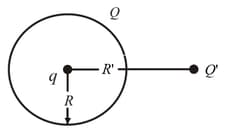Two uniformly charged non-conducting hemispherical shells each having uniform charge density and radius form a complete sphere (not stuck together) and surround a concentric spherical conducting shell of radius . If hemispherical parts are in equilibrium then minimum surface charge density of inner conducting shell is:

Important Questions on Electrostatics
A charge is placed at the centre of a conducting spherical shell of radius , which is given a charge . An external charge is also present at distance from . Then the resultant field will be best represented for region by: [ where is the distance of the point from ]

A charge is placed at the centre of a conducting spherical shell of radius , which is given a charge . An external charge is also present at distance from . Then the resultant field will be best represented for region by, [where is the distance of the point from ]
In the above question, if is removed then which option is correct.

Two identical charged spheres suspended from a common point by two light strings of length , are initially at a distance apart due to their mutual repulsion. The charges begin to leak from both the spheres at a constant rate. As a result, the spheres approach each other with a velocity . If denotes the distance between the spheres, the varies as
Acidified water from a certain reservoir kept at a potential falls in the form of small droplets each of radius through a hole into a hollow conducting sphere of radius . The sphere is insulated and is initially at zero potential. If the drops continue to fall until the sphere is half full, the potential acquired by the sphere is
